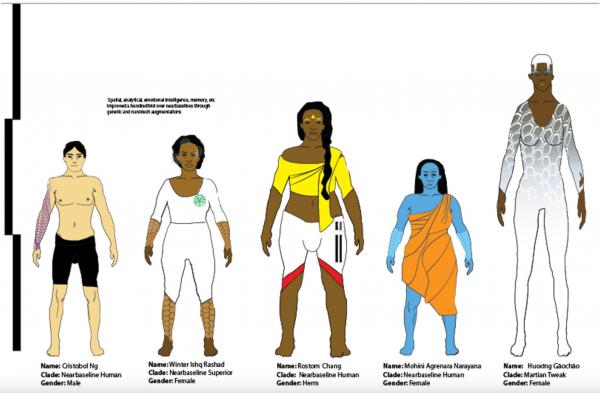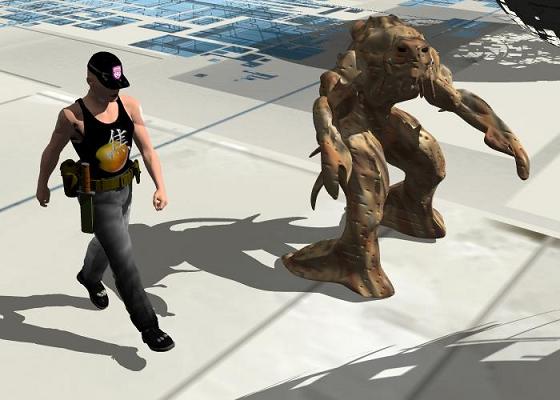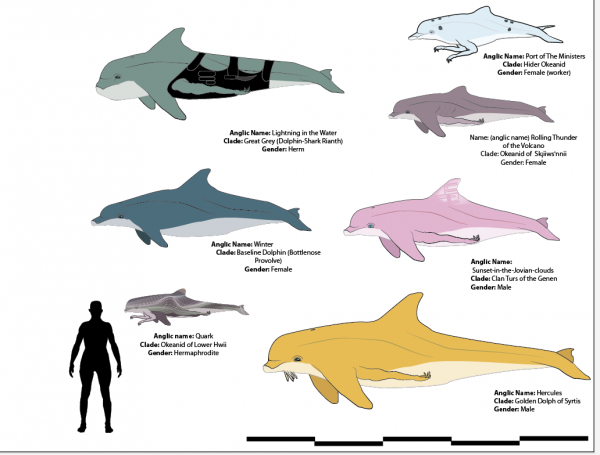BY LETTER
Modosophonts
 Image from Worldtree |
Typically the most common form of sophont in the Civilised Galaxy, a modosophont can be a baseline or near-baseline human, or a member of a human derived species, or a provolve, a vec, an alife or any of the hybrid phyles such as cyborgs.
 Image from Worldtree |
From Mode (in statistics, the value that has the largest number of observations) and Sophont (a self aware,"wise" being).
Definitions
n.
1. Sapient being of less than transapient level. SI:>1 on the Berram7 Singularity Scale (namely sapient, turingrade to superturing and any self-aware being under first singularity)
adj.
1. Possessing a level of sapience less than transapient but greater than an non-sapient animal. A typical sophont.
2. Of, relating to, or characteristic of, a modosophont.
Modosophont Technology
Before the First Singularity, Human baselines and other modosophonts developed basic artificially intelligent entities, basic human augmentics, basic nanotechnology, biotechnology, synsects, and 'Stage 1' programmable matter.Core technologies developed before the First Singularity
- Forge-based nanotech.
- Some limited replicating swarm (goo) tech, but control and stability issues limited the application of swarm technology.
- Synsect swarms were developed, but with a restrictive upper limit to effective coordination/control. Above several million units, control issues became overwhelming for either synsect or nanoswarms operating in a natural environment and performing complex or varying tasks without external control signals.
- Utility Fog and smart, programmable matter developed.
- Antimatter weapons such as Boom Bullets; but antimatter remains expensive.
- 'Plasma conduit' electrical transmission technology, allowing high energy currents to be transferred using controlled beams of plasma.
- Advanced lasers for energy transmission, in-flight particle defence lasers for spacecraft, weapons, igniting/maintain reactions in fusion/conversion reactors.
- Propulsion Technology:
- Basic mass-stream technology such as the Lofstrom Loop.
- Destructive and Gradual Uploading technology
 Image from Worldtree |
Some technologies were developed by transapients who then either gave them directly to modosophonts as gift technologies, or gave them pointers, guidance or simply vague hints which allowed the modos to invent the technology in question independently.
Other technologies were invented by transaps but were never given to modos, who nevertheless developed them independently later, sometimes by reverse engineering, sometimes with little or nothing to go on but a few vague rumours.
A few technologies were developed by modos on their own in their own time, and apparently never developed by transapients or never explicitly revealed to modos.
On the other hand many highly advanced technologies were developed by transaps and have remained beyond modosophont understanding and seem likely to remain so.
See also Modosophont level Hi-tech
 Image from Anders Sandberg |
Slang Terms for Modosophonts
Modie, Modo - relatively polite terms used throughout the Terragen SphereMo-pho, Mofo - somewhat less polite slang versions of the term Modosophont, often used as an expletive or perjorative.
Neb, Nebbish - slang for nearbaseline (of any species, but often nearbaseline human)
Hot, HOT, 'hard of thinking' The term "hot" or closely similar variants is widespread throughout Anglic languages to denote baselines and it is of great antiquity. Examples have been found dating back to the first millenium A.T. Many etymologies have been proposed but only three are still taken seriously.
1) For reasons now unknown, the first superturings and the early transapients were termed "cool". Those below that intelligence level acquired the epithet "hot" as an antonym. Initially used only adjectivally the term subsequently became a noun. C.f. "red" as a term for a member of any of many political groupings past and present
2) A monosyllabic interrogative pronoun *at or *ot exists in essentially all languages in the Anglic family. The oldest known variant is hwæt. In English from at least the industrial age the two leading consonants had been transposed and the word became what. Curiously and again for unknown reasons the vowel sound changed to o despite the spelling remaining constant. Subsequently, the h and/or the w consonants were dropped in some dialects and the spelling rationalized so the vowel was written as pronounced ---- o. The spelling wot appears in the first century A.T and may be somewhat earlier. Hot appears rather later in surviving records but may have been contemporaneous with what, wot and wat; the hat variant seems to have taken at least several decades more to develop.
The early su and S1 entities were amused by commonly hearing "Hot?" in response to attempted explanations and the term stuck.
3) An abbreviation of "hard of thinking".
Sub-Topics
| Aioids and Sophtware | Baseline Human | Bionoid |
| Biotech Cyborg (Bioborg) | Homo Superior | Nanocyborg, Nanoborg |
| Near-Baseline Human | Neogen | Neumann |
| Parasapient A-life | Provolve | Rianth |
| Sapient Structures | Sophont Ships | Splice |
| Sybont | Tweak | Vec |
| Virtuals | Xenoprovolve | Xenosplice |
Articles
- Clade (sophontology) - Text by M. Alan Kazlev
An evolutionary branch of mindkind defined by a common ancestral group or a common template that provides distinguishing characteristics for all members of that clade. - Cladistics - Text by M. Alan Kazlev
The science of creating evolutionary trees of ancestry and descent; classifying organisms based on common ancestry and the branching of the evolutionary family tree. - Class (sophontology) - Text by M. Alan Kazlev
A major category of sapient beings, as defined by one or a few basic but distinctive and generic qualities, not necessarily connected by ancestry (i.e. biont, ai, vec, bioborg). - Flatland, Flatlander - Text by M. Alan Kazlev
Flatland is a term for the state of existence beneath the first singularity Flatlander is a sentient being of SI:<1 toposophic. These terms are derived from Old Earth Atomic Age hu Edwin A. Abbot's mathematical fantasy Flatland: a Romance of Many Dimensions which describes two-dimensional creatures unaware of the third dimension of space. - Fragmentation - Text by You can call me Al for now
A form of temporary abdication, sometimes done voluntary but usually a form of punishment that higher transapients inflict on lower transapients for overstepping their bounds in dealing with nearbaselines or equivalent sapients. - Inhabitants of the Sephirotic Empires - Text by M. Alan Kazlev, amended by Steve Bowers
The major classes of thinking being that inhabit the typical Sephirotic Empire. - Ireaders - Text by Tony Jones
Modification — later clade — with increased linguistic ability, extending it to give an instinctive childhood ability to learn not only spoken but also written language, as easily as an unmodified baseline human learns to speak. - Leftbehind - Text by M. Alan Kazlev
Sometimes when a sophont ascends to a new toposophic level, it leaves behind or constructs or copies one or more representatives of its pre-ascended state. These leftbehinds may maintain a close connection with their Greater Self, serving as fully free proxavs. Or they may be released or encouraged to explore alternative (non-ascended) destinies. Sometimes Leftbehinds themselves eventually ascend, and in some cases these in turn leave their own leftbehinds. - Memenger - Text by M. Alan Kazlev
(Pronounced Me men jer.) A meme messenger; a sophont that acts like messenger RNA in transmitting memetic instructions from one society, polity, habitat, or civilization to another, as part of the message transmission within the ecology of an archailect. Usually the message is transmitted once, there is no replication or virus like behavior (unlike memetic infectors. Depending on the target population, a memenger may be biont, cyborg, artificial (vec, aioid, ai, etc), or virtual.
Among the many types of memengers are: - Memetic Infector - Text by M. Alan Kazlev
A sapient being used to infect societies or communities with a particular memeset. Memetic infectors resemble ordinary sophonts, but may differ psychologically, often having fanatical or one-sided enthusiasm for the meme-plex they are carrying. Infectors may be replicators (viruses) or non-replicators (memengers). - Memoid - Text by M. Alan Kazlev
A sophont who has been programmed by a higher toposophic to carry a memetic payload and infect a target community or environment. - Morphotype - Text by Stephen Inniss
In biology, or in the study of clades, a shared shape and general appearance, regardless of origin or relationship. The result of convergent evolution in natural beings, or of common design solutions or purposeful imitation in artificial beings. - Musical Eugenic - Text by Jay Dugger and John B
Any individual or clade geneered for musical talent or traits. - Neb - Text by M. Alan Kazlev
Colloquial term for a human nearbaseline. - Optimals - Text by Tony Jones
Any of a wide variety of bionts who have been re-engineered not for superior mental or physical skills, but simply to make their functioning as streamlined and biologically efficient as possible. - Pronouns, Early Anglic - Text by M. Alan Kazlev, Daniel Eliot Boese, Mark Ryherd, Stephen Inniss and Steve Bowers
A number of new pronouns became current in Early and Middle Anglic and descended languages as new kinds of sophont being became common. - Retro Abo - Text by Stephen Inniss
A population or individual that is the result of an attempt to reproduce the morphotype or even the culture and behaviour of some past clade, race, or local population. The term most often refers to individuals or groups who resemble past human baseline or nearbaseline groups. - Slearners - Text by Tony Jones
Modification - later clade - similar to Slinguists, but augmented in all the learning abilities of the sophont, allowing the acquisition of all kinds of skill, major and minor, physical and mental, with the same ease as a very young child. - Slinguists - Text by Tony Jones
Modification — later a clade — more advanced than Ireaders, having not just an instinctive childhood ability to learn written communications, but made that highly efficient childhood learning process a permanent second 'layer' of ability when learning to communicate. - Species - Text by M. Alan Kazlev
The basic unit of biological classification in Linnean or neoLinnean systems. - Su, superior - Text by Steve Bowers
Any modosophont biont clade which has a general level of intelligence greater than that of a nearbaseline human, but less than a transapient. Also sometimes applied to vecs and aioids with a similar level of ability. - Synclade - Text by M. Alan Kazlev and Stephen Inniss
A clade that results when two or more older clades of separate derivation merge to create a new group with its own distinct set of heritable traits (morphotype, physiology, toposophy and psychology etc.). Some better known examples include the Radiation Nation and the SynBios of the Black Acropolis. - Toposophic Level and Brain Size - Text by Todd Drashner
Processing substrate parameters, from Modosophont level to the Third Singularity. - Twin Clades - Text by Matthew C. Johnson
Biont clades which have been gengineered to consistently produce twin pregnancies.
Related Topics
Development Notes
Text by Thorbørn Steen
Steve Bowers, Xilman, images by Arik (2014)
Initially published on 12 November 2005.
Steve Bowers, Xilman, images by Arik (2014)
Initially published on 12 November 2005.
Additional Information







